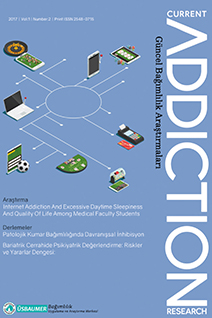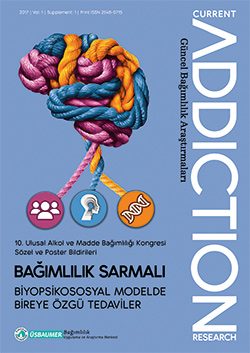ARTICLES
Original Article
Comparison of the Attachment Styles of Cigarette Smokers and Nonsmokers
Beyza Yaz,Hüseyin Ünübol,Gökben Hızlı Sayar
2019, 3(1), s:11-15
Aim: This study aimed to compare the attachment styles of smokers and nonsmokers.
Methods: 2800 individuals who participated in the study were given sociodemographic form and “Experiences in Close Relationships Scale”.
Results: Younger ages, male sex, low educational levels found to be related to smoking status. However smoking status or the number of daily smoked cigarettes not found to be related to attachment style.
Conclusion: According to the results of the study, attachment styles were not significantly different according to smoking status. The results of this study suggest that the other comorbid psychopathologies might be a more important risk factor than attachment style in smoking.
Original Article
The Comparison of The Theory of Mind in Internet Addicted And Non-Addicted University Students
Nuran Korkmaz,Hızlı Sayar Gökben,Hüseyin Ünübol,Nevzat Tarhan
2018, 2(1), s:17-21
Aim: The purpose of this study is to compare the university students having diagnosed as internet addicted and internet non-addicted in terms of the theory of mind.
Methods: The study group consisted 50 undergraduate students at Üsküdar University. 25 students diagnosed an internet addicted composed the study group. 25 students who have same sex with the study group subjects, however do not have any internet addiction, composed the study group.
Results: The average age of the students is 22.74±1.45. Data was collected by using sociodemographic data form, Internet Addiction Scale and the Dokuz Eylül Theory of Mind Scale. The study group found to have statistically significantly lower scores in theory of Mind Scale, when compared to the control group.
Conclusion: This result suggests that internet addiction may affect the students’ social interaction, emotional and cognitive processing.



 2. Sayı
2. Sayı
 1. Sayı
1. Sayı
 Ek Sayı
Ek Sayı







